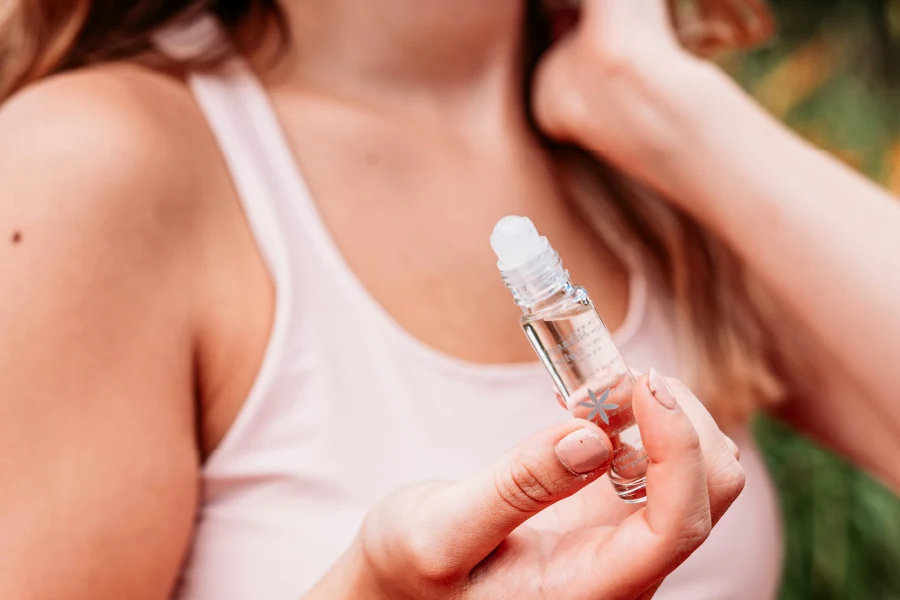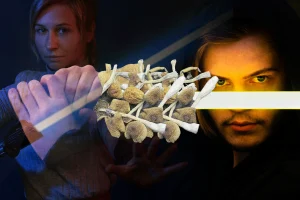If you have ever taken a handful of lavender flowers, rubbed them between your palms, and breathed in their scent, you may have felt immediate sensations of relaxation, elevation, and calm all at the same time. Lavender is known for its soothing and calming properties, and many people turn to lavender oil for those benefits on a more everyday basis.
There are a few ways to make lavender oil. The first is to extract the essential oil from the herb itself, using a still. This offers the most potent and most aromatic oil that offers the true essence of the plant. Other related extractions are hydrosols, herbal oil, and essences.

READ: 6 Herbs to Enhance Your Next Psychedelic Trip
What Is an Essential Oil?
An essential oil is the pure, volatile, aromatic essence extracted from a plant. These can be obtained through various methods, with steam distillation being the most common. In this process, a still is filled with water, the plant material is added to the chamber, heat is applied to bring the water to boiling, steam passes through a closed container and is then condensed through cooling, separating the essential oil from the water. The remaining water, which retains the essence of the essential oil, is known as a hydrosol. Typically, plants yield 1-2% essential oil of the total weight of the raw materials. Fresh plant material contains 40% more essential oils than dried.
If the use of the word “volatile” in the previous paragraph raised red flags, don’t worry: This does not mean the oils will explode or that they are dangerous. In the context of essential oils, the term “volatile” refers to the ability of the oil to evaporate quickly at room temperature. Volatile compounds are those that readily vaporize, releasing their aroma into the air. This characteristic is crucial for essential oils because it allows them to be easily perceived by our sense of smell, making them effective for aromatherapy and other applications.
Volatility in essential oils is due to the presence of small, lightweight molecules that can transition from a liquid to a gas state at relatively low temperatures. These volatile compounds are responsible for the strong, distinctive fragrances of essential oils and contribute to their therapeutic properties. Examples of volatile compounds found in essential oils include terpenes, aldehydes, esters, alcohols, and ketones.
Another extraction method for essential oils, called expression (also known as scarification or mechanical pressing), is used for plant materials like citrus peels or flowering leafy herbs such as mint or basil. Expression is used for plants that are sensitive to the high heat of distillation, producing a product known as an “absolute.”
How to Grow Shrooms Bundle
Take Both of Our Courses and Save $90!
READ: The Astrological Significance of Planets As Queer Elders
What is Lavender Essential Oil?
Lavender (Lavandula angustiolia) is part of the Lamiaceae or the mint family. To make a lavender oil or any product using the herb, the flower parts are used. The primary constituents found in lavender essential oil are linalool, linalyl acetate, borneol, camphene, cineol, terpinen-4-ol, alpha-pinene, and beta-myrcene. If you are a fan of cannabis, you may recognize some of these terpenes that are also found in many cultivars of cannabis.
Linalool and beta-caryophyllene are known calming agents and provide relief from symptoms of anxiety. While myrcene is known to deliver feelings of relaxation in the mind and body. Alpha pinene offers clarity of the mind. The underlying mechanism of action is centered in the region of the brain called the hippocampus, where serotonin receptors are activated and produce an anxiolytic effect.

What is Lavender Essential Oil Used For?
Lavender essential oil is the purest and most concentrated form of extract from lavender flowers. It is known for its soothing and calming properties. Lavender essential oil is commonly used in aromatherapy, skincare, and as a natural remedy. It is often used to promote relaxation, alleviate stress, and aid sleep. Some essential oils from specific species of lavender are high in monoterpenes and can be used to treat burns and skin irritations.

Benefits of Making Lavender Essential Oil
The benefits of making lavender essential oil extend to physical, mental, and emotional health, making it a versatile and valuable addition to any natural health regimen. It can be used as a natural air freshener, insect repellent, and in homemade cleaning products due to its pleasant scent and antimicrobial properties. Making your own lavender essential oil allows you to control the purity and quality, ensuring it is free from additives and synthetic ingredients.
How to Make Lavender Essential Oil Room or Linen Spray
This DIY lavender room spray is a natural and pleasant way to freshen up your living spaces. It will last for six to 12 months with proper storage (in a clean spray bottle stored in a cool, dark place).
Ingredients:
- 1 cup distilled water
- 2 tablespoons witch hazel or vodka (acts as a preservative and helps the oil mix with the water)
- 10 to 20 drops of lavender essential oil (adjust based on your preference for scent strength)
- A small spray bottle, preferably opaque to minimize exposure to light to maximize shelf life. (Plastic is OK to use, but glass is preferable. Do not use aluminum or any reactive metals. Reactive metals are those that undergo a chemical reaction when they come in contact with certain substances, like those found in plants, or solvents like alcohol.)
Instructions:
- Prepare the spray bottle: Ensure your spray bottle is clean. You can rinse it with warm water and soap, and let it dry completely before use.
- Combine Witch Hazel/Vodka and Essential Oil: In a small bowl or directly in the spray bottle, mix the witch hazel or vodka with the lavender essential oil. Stir or shake well to combine. This helps the oil disperse more evenly in the water.
- Add Distilled Water: Pour the distilled water into the spray bottle, leaving a little headspace at the top to allow for shaking.
- Mix the Ingredients: Close the spray bottle tightly and shake well to mix all the ingredients.
- Label and Store: Label your spray bottle with the contents and the date. Store the spray in a cool, dark place to preserve its freshness.
- Use the Spray: Shake the bottle before each use to ensure the ingredients are well mixed. Spray around the room or on your linens, as desired, for a fresh lavender scent.
Tips:
- You can adjust the number of drops of essential oil based on how strong you want the scent to be.
- Feel free to experiment with adding other essential oils, such as lemon or eucalyptus, to create a custom blend.
- If you don’t have witch hazel or vodka, you can use rubbing alcohol as a substitute. Not for consumption.
How to Make Lavender Essential Oil with a Still
Making lavender essential oil in a still involves the process of steam distillation. An essential oil still is a key device used to extract essential oils from aromatic plants through the processes of heating and vaporizing the plant material. This still is a component of a broader assembly that incorporates a condenser, sources of heat, vessels for collecting the oil, and filters. Here’s a step-by-step guide:
Materials Needed:
- Fresh or dried lavender flowers
- Distillation apparatus (still)
- Heat source
- Water
- Collection container
- Cheesecloth or strainer
Instructions:
- Harvesting Lavender: Collect fresh lavender flowers when they are in full bloom, ideally in the morning after the dew has evaporated but before the sun gets too hot. If using dried lavender, ensure it is properly dried and free from moisture.
- Preparing the Still: Set up your still according to the manufacturer’s instructions. Fill the boiler with water. Ensure all parts are clean and securely connected. The material of the still must not alter the scent or taste of the steam or liquid. For instance, rubber seals that are not chemically resistant should be avoided, as they could impart a rubbery smell to the oil. Optimal materials include heat-resistant glass, stainless steel, or copper, as these do not affect the quality of the end product.
- Loading the Still: Place the lavender flowers in the still’s flavor basket or plant material chamber. Do not pack them too tightly; allow steam to pass through the plant material.
- Heating: Heat the still. As the water boils, steam will pass through the lavender flowers, extracting the essential oils.
- Condensation: The steam carrying the essential oils will move through the condenser, where it will cool and condense back into a liquid. This liquid will then flow into the collection container.
- Separation: The collected liquid will consist of both essential oil and hydrosol (floral water). Essential oil will typically float on top of the hydrosol.
- Collecting the Essential Oil: Allow the mixture to settle, then carefully separate the essential oil from the hydrosol. This can be done using a separatory funnel or by carefully skimming the oil off the top.
- Storing the Essential Oil: Transfer the essential oil into dark glass bottles to protect it from light and store in a cool, dark place. Label the bottles with the date and type of oil.
Tips:
- Quality: Use only healthy, pesticide-free lavender flowers for the best quality oil.
- Yield: Be aware that the yield from lavender can be quite low (around 1-2% of the plant material’s weight), so you will need a significant amount of lavender to produce a small quantity of oil.
- Hydrosol: Don’t discard the hydrosol; it can be used for various purposes such as in skincare products, as a room spray, or in cleaning solutions.
How to Make Lavender Oil Without a Still
Making lavender oil without a still is more accurately described as creating an infused oil, rather than a true essential oil. This method produces a lavender-infused oil that retains many of the aromatic and therapeutic properties of lavender, suitable for various uses such as massage, skincare, and aromatherapy. Here’s a simple method to make lavender-infused oil at home:
Materials Needed:
- Fresh or dried lavender flowers
- Carrier oil (Like olive oil, sweet almond oil, or jojoba oil)
- A clean glass jar with a lid
- Cheesecloth or fine strainer
- A dark glass bottle for storage
Instructions:
- Preparing the Lavender: If you are using fresh lavender, let it wilt for a day or two to reduce its moisture content. This helps prevent mold in the oil.
- Filling the Jar: Fill the glass jar about halfway with the lavender flowers. Don’t pack them too tightly.
- Adding the Carrier Oil: Pour the carrier oil over the lavender flowers, ensuring they are completely submerged. Leave about an inch of space at the top of the jar.
- Infusing the Oil: Seal the jar tightly and place it in a warm, sunny spot, like a windowsill. Let it sit for 4-6 weeks, shaking the jar gently every few days to help mix the contents.
- Straining the Oil: After the infusion period, strain the oil through cheesecloth or a fine strainer into a clean bowl. Squeeze the lavender flowers to extract as much oil as possible.
- Storing the Infused Oil: Transfer the strained oil into a dark glass bottle to protect it from light, which can degrade the oil. Store the bottle in a cool, dark place. It will stay good for up to one year, if stored properly.
Tips:
- Quality of Lavender: Use high-quality, pesticide-free lavender for the best results.
- Carrier Oil: Choose a carrier oil with a neutral scent and good shelf life. Olive oil, sweet almond oil, and jojoba oil are all good options. If you plan to use topically on the skin (particularly on sensitive skin or the face), choose a non-comedogenic oil, so as not to irritate or clog pores.
- Sunlight: While sunlight helps in the infusion process, ensure the jar is not exposed to extreme heat, which can degrade the oil.

DoubleBlind is a trusted resource for news, evidence-based education, and reporting on psychedelics. We work with leading medical professionals, scientific researchers, journalists, mycologists, indigenous stewards, and cultural pioneers. Read about our editorial policy and fact-checking process here.

DoubleBlind Magazine does not encourage or condone any illegal activities, including but not limited to the use of illegal substances. We do not provide mental health, clinical, or medical services. We are not a substitute for medical, psychological, or psychiatric diagnosis, treatment, or advice. If you are in a crisis or if you or any other person may be in danger or experiencing a mental health emergency, immediately call 911 or your local emergency resources. If you are considering suicide, please call 988 to connect with the National Suicide Prevention Lifeline.



